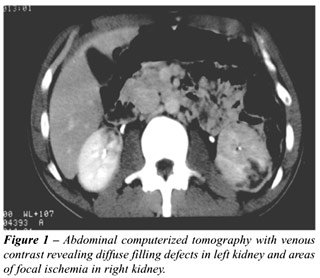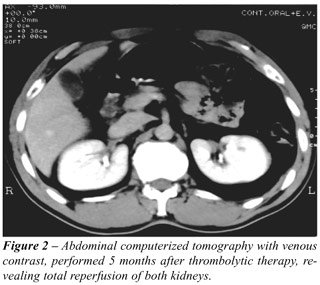THROMBOLYTIC
THERAPY IN BILATERAL EMBOLISM OF RENAL ARTERIES BRANCHES
(
Download pdf )
MARCELO F. CASSINI, PATRÍCIA L. CASSINI, RODRIGO L. RUSSO
Section of Urology, Internal Medicine, and Intensive Care, Santa Casa de Misericórdia, São Sebastião do Paraíso, Minas Gerais, Brazil
ABSTRACT
Bilateral
renal artery embolism is rare, but it is a significant cause of arterial
hypertension and renal failure, and most often is associated with cardiac
arrhythmias. We report a case of bilateral renal artery embolism with
a satisfactory outcome following use of thrombolytic therapy.
A 42 year-old Caucasian man presented a
sudden complaint of intense abdominal pain, in mesogastrium and left flank
with dorsal irradiation, 3 days after electrical cardioversion due to
cardiac arrhythmia. Laboratory tests revealed slight leukocytosis, hematuria,
and creatinine of 1.8 mg/dL. Chest radiography was normal and computerized
tomography showed an area of massive ischemia in left kidney, and focal
ischemia in right kidney and spleen.
The patient was then submitted to systemic
venous therapy with 1.5 million units of streptokinase, with an excellent
outcome.
Key
words: kidney; renal artery; embolism; therapeutics; thrombolytics
Int Braz J Urol. 2003; 29: 147-8
INTRODUCTION
Bilateral
acute occlusion of renal artery is rare, but it is a significant cause
of renovascular systemic hypertension and renal failure. In most cases
it is associated to cardiac diseases, particularly arrhythmias (55% atrial
fibrillation) (1), and can occur also in blunt trauma, renal artery stenosis,
iatrogenic angiographic manipulation, cocaine injection, use of intra-aortic
balloon, among others.
The purpose of this work is to report a
case of bilateral acute renal embolic ischemia with excellent outcome
following systemic thrombolytic therapy.
CASE REPORT
A
42 year-old Caucasian man was admitted in hospital (3 days after release
from an electrical cardioversion due to atrial fibrillation), presenting
intense abdominal pain for 1 hour, with sudden onset, in mesogastrium
and left flank with dorsal irradiation, associated with profuse sweating,
psychomotor agitation, abdominal distension, vomiting and oliguria. The
abdomen was diffusely painful during palpation, without signs of peritoneal
irritation. Cardiac rhythm was regular and sinus. Laboratory tests revealed
slight leukocytosis, with urinalysis showing hematuria (+++), creatinine
of 1.8 mg/dL and blood urea nitrogen of 90 mg/dL. Chest and abdomen radiographies
were normal.
The abdominal computerized tomography (CT)
revealed the presence of a large ischemic area in left kidney, as well
as an area without perfusion in the upper pole of the right kidney, and
focal ischemia in spleen (Figure-1). Echocardiogram revealed no intracavitary
thrombus.

The patient received 1,500,000 IU of intravenous
Streptokinase, due to hospital limitations to perform selective intra-arterial
thrombolytic therapy, followed by full heparinization and analgesia, with
a good outcome, with restoration of diuresis. Hematuria subsided in the
fifth day and the patient was released in the tenth day, with serum creatinine
of 1.2 mg/dL, using warfarin sodium 5mg/d and amiodarone 200 mg/d.
A new abdominal CT, performed 5 months later,
showed total reperfusion of renal ischemic areas with a small residual
infarct lesion in the spleen (Figure-2). Currently, the patient keeps
an outpatient follow-up, is assymptomatic, normotense and with creatinine
of 1.0 mg/dL.

DISCUSSION
Clinical
manifestations of uni- or bilateral renal artery embolism are unspecified
and inconsistent, and that is why the diagnosis can take some time to
be made (2). It must be always considered in cases of intense and sudden
abdominal pain in patients with a history of cardiac arrhythmias or valvar
disease. Mesenteric thrombosis must be excluded.
The diagnosis is confirmed by CT or renal
arteriography, and currently the first-choice treatment, for embolism
either in renal arteries or in one of their branches, is selective intra-arterial
thrombolytic therapy (streptokinase), within a period lower than 3 hours
from the initial symptoms (2,3). In case of delayed diagnosis, anticoagulation
is used, even though procedures such as embolectomy and more aggressive
surgeries (autotransplantation, aortorenal bypass) remain as a therapeutical
option as well, in specialized centers, but with higher morbidity and
mortality (3).
REFERENCES
- Blum U, Billmann P, Krause T, Gabelmann A, Keller E, Moser E, et al.: Effect of local low dose thrombolysis on clinical outcome in acute embolic renal artery occlusion. Radiology 1993; 189:549-54.
- Gasparini M, Hoffman R, Stoller M: Renal artery embolism: Clinical features and therapeutic options. J Urol. 1992; 147:567-72.
- Morris D, Kisly A, Stoyka CG, Provenzano R: Spontaneous bilateral renal artery occlusion associated with chronic atrial fibrillation. Clin Nephrol. 1993; 39:257-9.
_______________________
Received: October 10, 2002
Accepted after revision: March 12, 2003
_______________________
Correspondence address:
Dr. Marcelo Ferreira Cassini
Av. Afonso Pena, 400
São Sebastião do Paraíso, MG, 37950-00, Brazil
Fax: + 55 35 3531-3175
E-mail: cassini@paraisonet.com.br